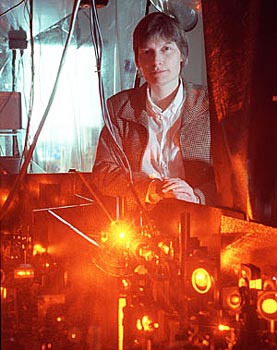Lene Hau
In 1999, after years of practice, Lene Hau learned how to bicycle at the speed of light. She's not a racer; she's a physicist at Harvard University. She didn't achieve this amazing feat by cycling faster; instead, she slowed light down - to an incredible 60 kilometers (37 miles) an hour. And just this year, she did something even more amazing - she stopped light dead in its tracks.

Lene Hau
Lene Hau (pronounced LEE-nuh HOW) always knew this, but she never expected to break the slow-speed record for light. She grew up in Denmark, and got a Ph.D. at the University of Århus, studying the physics of solids. After she graduated, she received a Carlsberg Foundation fellowship - an award given by the Danish brewery Carlsberg for study abroad. She visited several physics programs around the U.S., and was interested in the Rowland Institute of Science in Boston. “It was a fantastic research place,” she said. Soon after she arrived, she launched a new research project: the search for a new state of matter called the Bose-Einstein Condensate.
When atoms get extremely cold, a few millionths of a degree above absolute zero, they lose their individual identities and blend together. At low enough temperatures, a collection of millions of atoms can behave like a single “superatom.” This collection is known as the “Bose-Einstein Condensate,” after the two physicists whose work predicted its existence in 1924. “I was so curious to see what this new state of matter was like,” Hau said.
In June 1997, Hau and her co-workers finally cooled atoms enough to form a Bose-Einstein Condensate. “We were incredibly happy,” she said. “We had succeeded.” They were among the first people in the world to see those condensates.
After making the condensate, Hau and her co-workers began looking for ways to use it. They realized that if they massaged the condensate just right with laser beams, they could make light pass through the previously opaque condensate. And they found that the massaged condensate could slow light more effectively than any material ever discovered.
They used an electromagnet to suspend a cigar-shaped condensate, 0.2 millimeters (0.008 inches) long, inside a vacuum chamber. They first illuminated the cigar from the side with a finely tuned laser beam (the 'coupling' beam), and then shot a pulse of laser light along the long axis of the cigar. The pulse slowed down and compressed as soon as it reached the altered condensate. Hau worked late nights in the lab for a year, trying to perfect her experimental system for slowing light.
Finally, in March 1998, she began to see the light slow down. “I thought, 'gee, you are the first person to see light go this slowly,'” she said. That summer, when she flew to Copenhagen, she realized that she was traveling faster than her light beams. That fall, when she succeeded in getting light to travel at the speed of a bicycle, she decided to publish her results.
This year, her group took its experiments a step further by getting light inside a Bose-Einstein Condensate to stop completely. While the light pulse was totally compressed and contained entirely within the condensate, the team abruptly turned off the coupling laser. This adjustment left the light trapped inside. When they turned the coupling laser back on, the original light pulse came out the other end. “We can park a light pulse in the cloud for a millisecond,” Hau said. “It might sound short to you, but it's really long - long enough for light at its normal speed to travel 300 kilometers - and there's no doubt that we can get the storage times up.”
Slow or stopped light could someday be used in future computers that use light instead of electrons to carry and process information. Or, the light could be used by scientists to create simulated black holes in the lab. “Slow light has a tremendous variety of applications,” Hau said.
Hau recently moved from the Rowland Institute to a full-time job as a professor of physics at Harvard. She loves her work, even the long nights in the lab. But she always enjoyed long nights, especially summer nights in Denmark, when the sun sets at 10:30 PM and rises at 3 AM. When Hau is not in the lab, she enjoys bicycling - at the speed of slow light - around the beaches of nearby Cape Cod.











